Salmon Fishing Pulaski NY: Best Baits, Methods, and Access
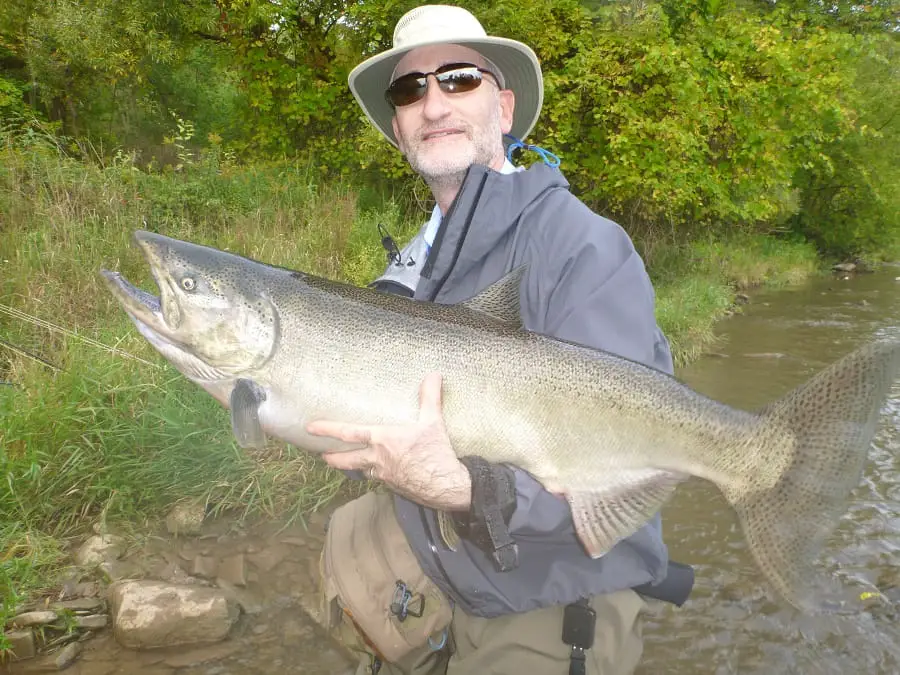
Salmon Fishing Pulaski, NY, is one of the most exciting times, but instead of going home empty-handed and frustrated, use the tips and advice from multiple salmon river guides to help you catch more salmon.
Salmon fishing in Pulaski, NY, starts in early September and consists of three salmon species that run up the famous Salmon River, which runs through town. The Chinook Salmon, also known as King Salmon, the Coho Salmon, and the Atlantic Salmon.
Access to fishing is generally good, and anglers can fish for salmon at the many access spots through the town of Pulaski as well as above or below the town.
There are multiple methods, effective baits, lures, and great salmon flies that the guides use. If you are not using the same and doing the same as the guides, you’re going to miss some huge king and coho salmon.
Pulaski NY Chinook Salmon
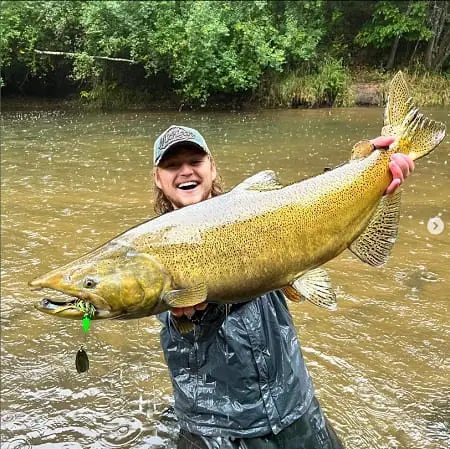
If you are going to fish for Salmon in Pulaski you should know that is popular because of the tens of thousands of returning adult Chinook Salmon that run up the famous Salmon River.
Chinook Salmon, also known as King Salmon, is the most common salmon species in this river. This is primarily thanks to the intensive stocking efforts by the New York Department of Environmental Conservation, which stocks the river with 300,000 Chinook Salmon yearly.
In the past, the department stocked the river with well over three million fingerlings of this species, but this high number became unsustainable.
The Chinook Salmon have earned the name King Salmon due to their large sizes and conspicuous appearance.
The average Chinook Salmon on the river weighs between 20 and 30 pounds. By comparison, the average Coho Salmon weighs between 9 to 15 pounds. This difference in size is remarkable. Uflyfish Guide Service says the average Coho in the river is closer to 12 to 20 pounds.
Sizes may vary depending on the food sources out in the lake as well as conditions.
You can quickly identify Chinook Salmon by their bright, silvery appearance, especially as they enter the river. But as they spend more time in the river, they become duller. The Chinooks also have a black mouth, black gums, and a fully spotted tail.
Chinook Salmon start their runs in late August and early September. The runs continue until mid-October, after which the number of these species dwindles as they spawn and die.
One factor that triggers King Salmon runs is an increase in water levels after the rains. Sometimes, when the dam releases excess water, it can also stimulate some salmon runs.
The fish typically spawn between October and November. Unfortunately, they die after spawning. You are, therefore, likely to come across plenty of dead Chinook Salmon in the river, especially if you plan your trip in November or December.
Given their high numbers, the Chinook Salmon are the main sport fishing attraction. Part of the reason that anglers love fishing this aggressive fish is the thrill of catching many very large hard fishing fish.
If you intend to catch a few King Salmon on your fishing trip, be prepared to battle with them. And when you do catch the fish, you will undoubtedly enjoy the exhilaration.
Chinook fishing in Pulaski can be excellent when anglers use the right methods and the right baits or flies. You also need the best type of net for salmon fishing.
Fly fishing and float fishing are the two most effective methods for catching salmon in Pulaski NY.
Anglers that use Spawn sacs, beads, flies, and plastic worms will usually do very well.
Coho Salmon
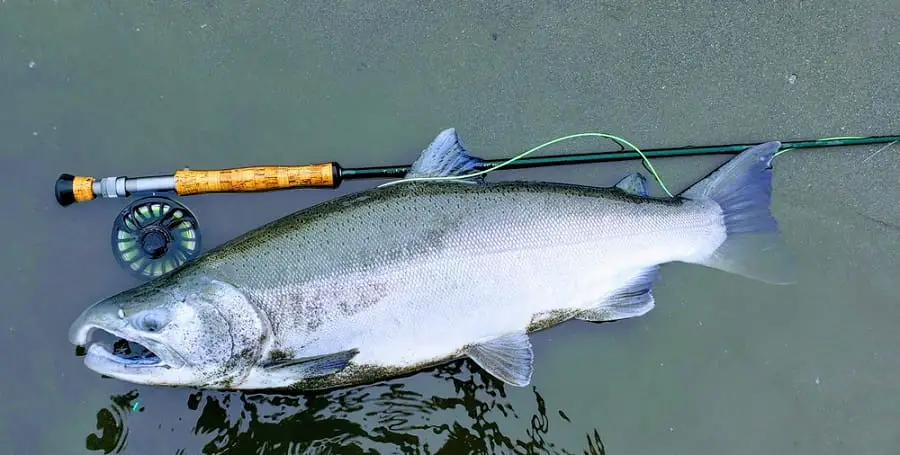
Coho Salmon are the second most common salmon species due to their abundance and their reputation for long runs, lots of jumps, and just a great fighting fish.
You can distinguish Coho from the Chinook Salmon by their smaller size and their white gums.
The average Coho Salmon is about 26 inches long and weighs between three to ten pounds. The New York DEC stocks the river with about 80,000 of this fish variety.
Like the Chinook Salmon, the Coho Salmon begin their runs in late August and early September. They also spawn at the same time as the king salmon. Unfortunately, they, too, die after spawning.
Anglers coho fishing in Pulaski will use the same methods and baits as they would when fishing for Chinook Salmon.
Atlantic Salmon
The Chinook Salmon may be the dominant salmon species, but the Atlantic Salmon gave the river its name.
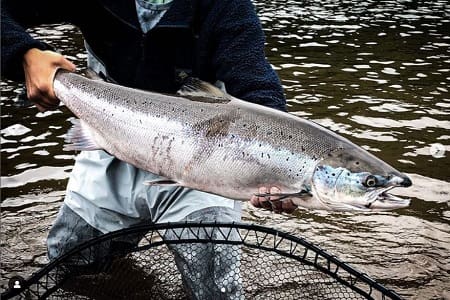
However, this salmon species is not as hardy as the Chinook Salmon and is easily affected by adverse environmental conditions.
At one point, all Atlantic salmon were wiped out of Lake Ontario, but with many new salmon stocking programs in New York and in Canada, anglers are starting to see a lot more Atlantic Salmon.
Unfortunately, since the Atlantic salmon are not as hardy, they struggle to survive in the lake and in the river.
This has been a hindrance to growing its population in the river despite the DEC’s intensive stocking efforts.
Like the Coho and Chinook Salmon, the Atlantic Salmon spawn in the fall, but they are known to run as early as June and July. However, unlike these two species, the Atlantic Salmon survives the spawn and can spawn 2 to 5 years in a row.
Some Atlantic Salmon start their runs in June, providing anglers with a bit of a summer fishery, and they can continue to be in the river through to November. Therefore, the best time to catch this species is in late summer and early fall.
You can quickly identify them by their white mouths, gums, and smaller heads.
Best Fishing Methods For The Salmon River, Pulaski NY
Fly Fishing
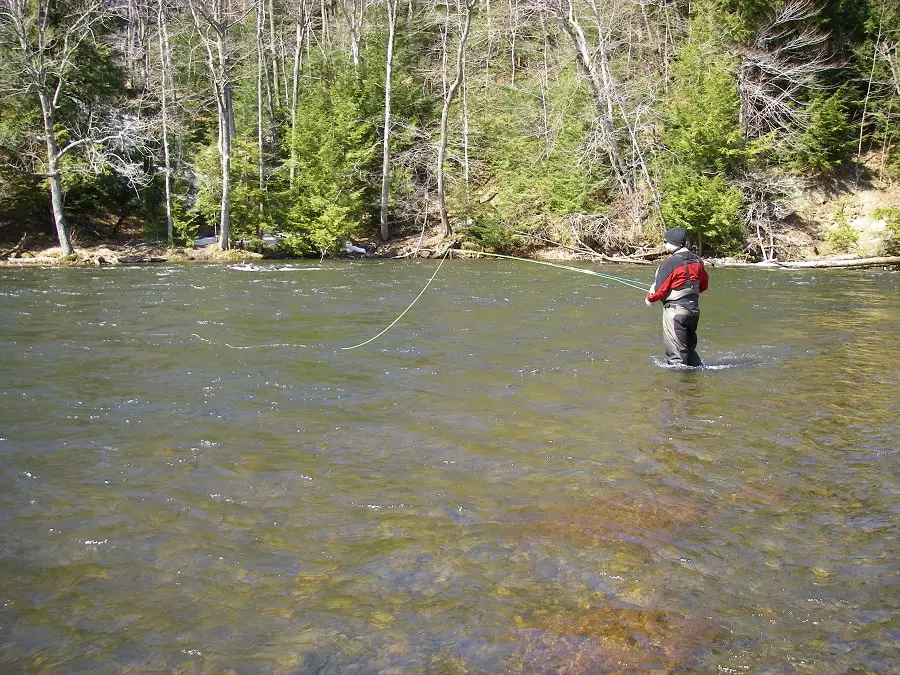
The guides from Cobble Creek Outfitters claim that their favorite way to take large kings and coho salmon is fly fishing. My favorite way to catch salmon is also fly fishing.
Fly fishing is one of the most effective methods and a very popular method with many anglers because of its versatility.
I use a variety of aquatic insect imitations, typically referred to as flies. Egg fly patterns, worm patterns, and baitfish patterns are also very effective.
There are three main fly fishing methods: nymphing, Spey fishing, and streamer fishing.
With nymphing, you typically dead drift your flies below an indicator and use weighted flies or split shots to get your flies deep and down where the salmon are holding. You set up your leader so that the fly sinks quickly and stays in the strike zone for a long time.
The great thing with nymphing is that often there are steelhead and brown trout mixed in with the salmon and they are often feeding on the salmon eggs and the aquatic insects that get dislodged and drift down the river.
There’s more to nymphing than that, and if you want to catch the most salmon consider learning how to salmon fish with indicators and with the Euro Nymphing method. Check out Fly Fishing For Salmon: Tactics Used By Guides For More Salmon
Spey and streamer fishing are very different from nymphing. With these methods, you use flies that imitate baitfish and are either swung across the pool or stripped in.
Local guides like to swing large streamer flies to big aggressive salmon. This method is a great way to get their clients coming back since it’s hard to forget the excitement of a large, aggressive king salmon smashing your streamer and nearly ripping the rod out of your hand.
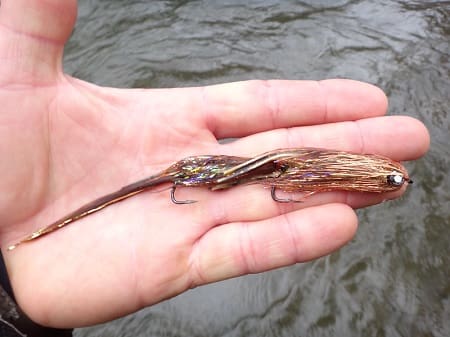
When fly fishing for salmon the streamer and Spey flies are much bigger with some being 4 to 6 inches long, these larger flies are great at attracting the larger salmon.
Adult salmon tend to be aggressive when spawning and tend to attack larger bait instinctively for food or to protect their territory.
Spin Fishing
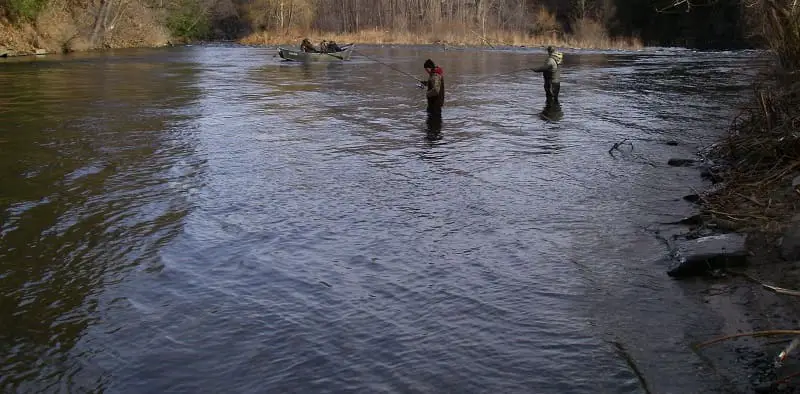
This is yet another fantastic method for catching salmon in Pulaski. Most experienced anglers will tell you that its effectiveness depends on your lure being presented correctly as you reel it in.
Spinners are an effective lure for salmon and you want your spinner to move naturally while producing vibrations to attract the fish. Spinners worth trying are size four or 5-blade Blue Fox Vibrax Minnow Spin and the Panther Martin Spinner. See Spinner Fishing For Salmon.
Spoons are another great option when fishing for salmon. Two spoons that I use and like are the Eppinger Daredevil spoons and the Mepps Syclops Spoon. See Spoon Fishing For Salmon.
Guide services like “Salmon River Guide” do very well with plugs. My favorites are similar or the same as what they use.
Chartreuse and sliver Kwikfish plugs, Flatfish Plugs, and Yakima Mag Lips are all excellent in slow to medium-speed currents.
Crankbaits are one of my favorites for big salmon. Some of my favorites include Storm Original Deep Thundersticks, Cotton Cordell Big O Crankbait, or 5.5 inch Rapala Down Deep Husky Jerk or the Rapala Shad Rap SR09 Hard Bait.
Cobble Creek Outfitter guides say they cast lures such as J-13 Jointed Original Rapalas for large salmon. I also like t J9 and J11.
With plugs like the Yakima Mag-Lip and crankbaits, cast them across the river on about a 45-degree angle and very slowly retrieve the lure.
Depending on the speed of the current, often it’s best to not retrieve at all and to just let the lure swing and wobble across the river.
With each cast, move down 2 to 3 feet and repeat.
There are other lures that can be very effective. With good presentation, spin fishing is a great way to catch salmon in the larger parts of the river. For more, see our article Best Salmon Lures And The Guide Tactics For Salmon In Rivers.
See also Crankbait Fishing For Salmon.
Casting and twitching jigs is less common in this area but it is very effective.
Float Fishing
Float fishing is yet another excellent method you can use to catch salmon in the river. When Salmon fishing in Pulaski, you will see a lot of anglers with long 12 to 15-foot float rods.
With float fishing, you are simply dead-drifting your bait or flies below a float.
For the best float fishing experience, you need to use the right equipment. Your reel, rods, and baits must be top-notch, and your leader setup must be impeccable. You need to cover the water effectively, and your depth and speed need to be right. I discuss all of this on my page Float Fishing For Salmon – Most Effective Great Lakes Tactics.
Bottom Bouncing For Salmon
Bottom bouncing is a method used to fish in faster water, and it excels in shallow runs, and pocket water. It can also be used in large pools and runs that have medium to fast currents.
With bottom bouncing, there is no float to suspend your bait; it’s just your line, some weights, and your bait, and with practice, you will be able to make good drifts and be able to detect even subtle bites.
With bottom bouncing, you can use most of the same baits you would use with float fishing. For more, check out Bottom Bouncing – 5 Proven Guide Tips For More Fish.
Best Baits for Pulaski Salmon
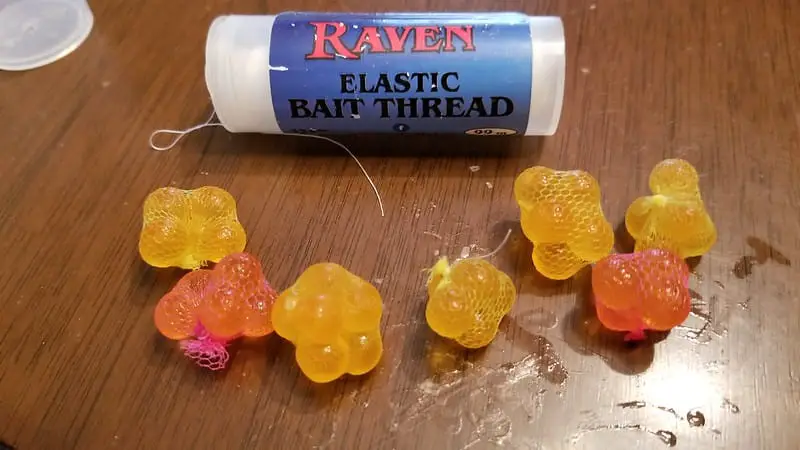
There are five or six baits that are very effective for salmon, and anglers should have multiple baits on them in case one bait is not working. Salmon that enter the river can be color and size-sensitive, so it’s a good idea to have a good selection.
Spawn
Spawn, also known as roe, or spawn sacs, consists of several salmon eggs tied in a special mesh.
It is a highly effective bait for salmon thanks to its high visibility and natural scent. If you are a beginner at salmon fishing, you might want to spawn sacs first.
You can also opt to use loose salmon eggs drift on a small hook. The salmon like the eggs, especially during the spawning season, as they help them maintain their energy levels. Additionally, salmon sometimes attack loose eggs purely out of instinct and territoriality.
Beads
Beads are also great for salmon in Pulaski. Beads resemble salmon eggs, and both soft and hard beads are easy to fish and very effective. In fact, in the last few years, many anglers are reporting that beads are their most effective bait for salmon in the Pulaski area.
For more on how to rig your beads, as well as the best beads and colors to use, check out Salmon Fishing With Beads.
Plastic Worms
Plastic worms also work well most times, when targeting salmon. Their extensive profile and colorful appearance make them attractive to the fish and it’s a large bait that is hard to miss and hard to pass up.
If you have been fishing with roe without much success, be sure to try out a worm before leaving a fishing spot. This is more so if other anglers in the vicinity are all using roe and are not doing well.
Sometimes, the fish need a change in a bite to catch their attention.
Some anglers are even using Marshmallows as bait for salmon with some success.
Flies
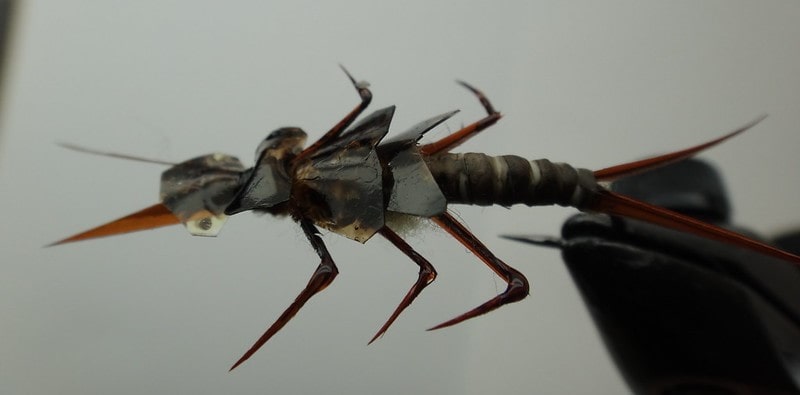
Flies are a delicacy for most fish species that live in the river, especially baby salmon. They also work well on the bigger fish, which consider flies to be a nutritious meal.
Flies make fantastic bait because they are extremely versatile, and they can be used under a float or when fly fishing. You can quickly tie your fly to suit the fishing conditions for the best results.
There are other great baits and secretes that the guides use for more salmon. Check them out at Best Baits For River Salmon.
Pulaski Fishing Spots and Access Routes
The area offers anglers 17 miles of fishing opportunities. However, only 12 of these have public fishing rights. You can easily access them through Routes 13, 11, and 81.
For the private fishing grounds, you must first seek the landowners’ permission before you can fish on them. You may also have to pay a fee to access these areas. One of the most prominent private fishing spots is the Douglaston Salmon Run, which offers anglers 2.5 miles of top-notch salmon fishing grounds.
Tight Lines
Graham
